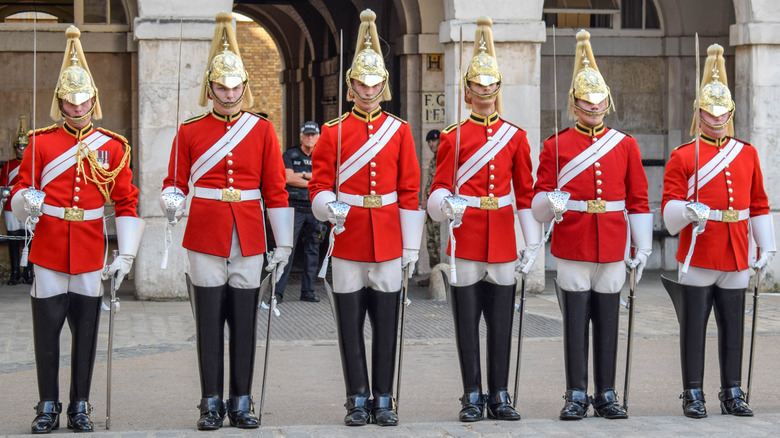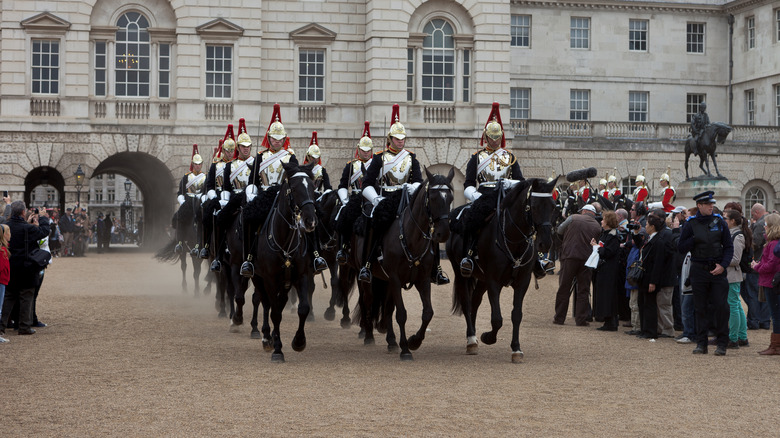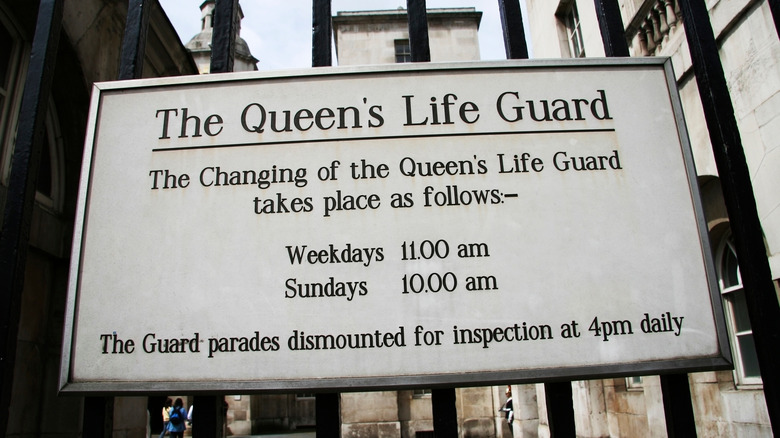It Turns Out There's A Good Reason The British Royal Guards Undergo A Daily Inspection
The Changing of Guard that happens at Buckingham Palace is a ceremony that takes place a few days a week and is watched by plenty of locals and tourists alike. There is a similar ceremony, though not as popular, that happens at Horse Guards in Whitehall, a historic building with an arch that serves as an entrance to Buckingham Palace and St. James' Palace (via Royal Parks). The original building was constructed on the order of King Charles II in 1663 to house military guards. The building was the base for trusted military personnel, and on the ground floor were hundreds of horses kept in a stable.
In 1698, however, Whitehall Palace was consumed by a large fire. As reported by Historic Royal Palaces, a maidservant was drying linen sheets on a brazier in the palace and left it unattended, something she wasn't supposed to do. The sheets caught ablaze and the fire quickly spread inside the palace, which back then was constructed out of timber. The fire blazed for 15 hours before it was put out, and the southern part of Whitehall Palace, as well as other parts of the building, suffered the most damage. After the fire, the Royal Court was transferred to St. James' Palace, and the Horse Guards had to transition from guarding a palace that was in front of them, to guarding one located behind them. The Horse Guard building had a few renovations and repairs done over the years, but the basic design was kept the same.
The Royal Horse Guards
The Horse Guards building is the headquarters of the Household Cavalry Mounted Regiment, which provides troops for the King's Life Guard (referred to as the Queen's Life Guard if the monarch is a woman). The King's Life Guard consists of soldiers from the Squadron of The Blues and Royals that are distinguishable by their red plumed helmets and blue uniforms, and soldiers from the Squadron of The Life Guards who wear white plumed helmets and red uniforms (via Walk London).
Just like in Buckingham Palace's Changing of the Guard, there is also a ceremony that takes place at Horse Guards when guards change shifts. Per the Household Division, the Long Guard, which consists of 10 troopers, one trumpeter, one office, two non-commissioned officers, and a corporal major, is on duty when the monarch is in London. In cases when the monarch is not in London, the security is reduced to the Short Guard, which is comprised of 10 troopers and two non-commissioned officers. The Changing of the Guard ceremony takes place daily at the Horse Guards Parade and the New Guard takes the place of the Old Guard with a royal salute. The ceremony is ideal for tourists and locals who want to have a close look at the pageantry, as there are fewer people and no barricades between the guards and the onlookers, as noted by Changing Guard, unlike at the Changing of Guard at Buckingham Palace, which draws larger crowds.
The Four 'O' Clock Parade
Apart from the Changing of Guard, there is another ceremony that takes place daily at the Horse Guards courtyard, which is called the Four 'O' Clock Parade, otherwise known as the Dismount Parade or the Punishment Parade. As the name suggests, the ceremony takes place daily at 4:00 p.m. During the ceremony, an officer inspects the guards standing at attention, as noted by City Guide London. The officer meticulously inspects the guards' uniforms, shoes, helmets, and overall appearance. This is also the time when mounted sentries are replaced by dismounted sentries, and the horses are led back to the stables for the remainder of the day. The dismounted sentries stand guard until 8:00 p.m., and they are then replaced by one sentry until the mounted guards come back at 7:00 a.m. the following day, according to Changing Guard.
There is a reason why the ceremony is also known as the Punishment Parade. Its history dates back to the reign of Queen Victoria. Per Commonwealth Walkway, in 1894, Queen Victoria paid an unannounced visit to check on the guards only to be met with disappointment. All of the guards who were supposed to be on duty were drinking and gambling upon her arrival, which, needless to say, was unacceptable behavior. From then on, she ordered an officer to do an inspection of the guards at 4 p.m. daily for the next 100 years as punishment. The punishment was completed in 1994, but Queen Elizabeth II insisted the daily inspection to continue as part of the tradition.


